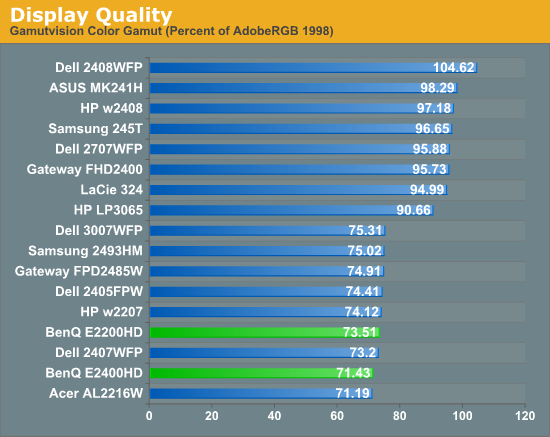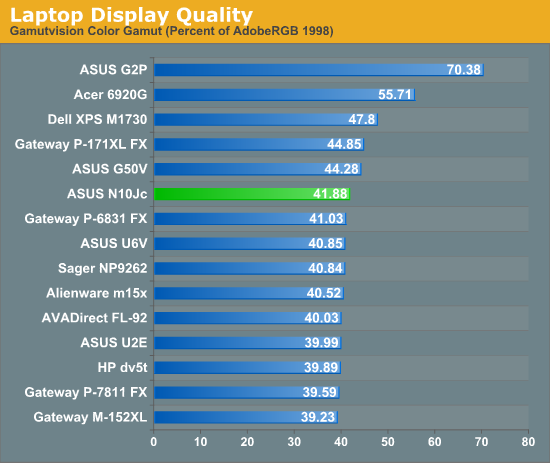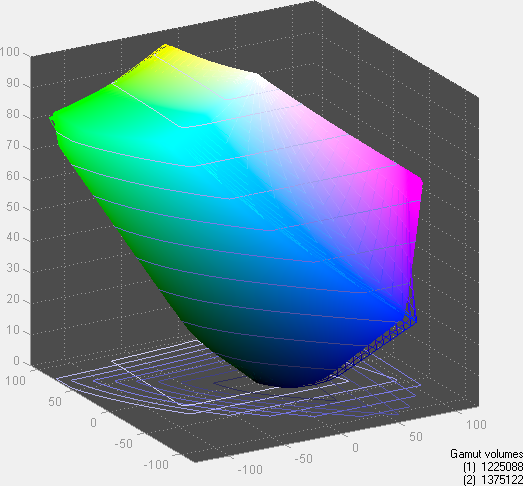Dell Studio XPS 16: Highest Color Gamut Ever?
by Jarred Walton on February 26, 2009 6:00 AM EST- Posted in
- Laptops
Okay, let's get something out of the way right off the bat: I started work on a review of the Dell studio XPS 16 before CES 2009. Originally intended to go live at CES, I decided to hold off in order to conduct additional testing and send some questions to Dell. Ultimately, we ran into some problems with the sample laptop, which is a prerelease version with a few kinks that need to be worked out. Ironically enough, the one major complaint in involves a glitch with the LCD on the unit we received, but we didn't notice this problem on any of the other studio XPS 16 laptops at the show. Anyway, I'm holding off on the full review until Dell can provide a retail sample, which should occur in the near future. In the meantime, one of the initial test results was shocking enough that I felt it was time for a blog. That's right: it's time to talk about laptop LCDs again!
When Dell claimed that the Studio XPS 16 would have the highest color gamut of any current laptop, I was a bit skeptical. I mean, the best color gamut I've seen up to now was on the ASUS G2P, which managed a rather impressive 70% of the Adobe RGB 1998 gamut. The next best LCD I've tested happens to be the Acer 6920G 1080P model, coming in around 55%. Everything else is roughly 45% or lower. On their own, such numbers don't necessarily mean a lot, so let's give a point of reference. Desktop LCDs from several years ago typically scored around 70% to 75% -- in other words the best laptop LCD I've tested to date might be able to match the entry-level desktop LCDs.
Here are a couple charts from the most recent reviews for laptops and LCDs showing how things stack up. To say that the laptop LCDs are uninspiring is a gross understatement.


As you might have guessed, the reason for this blog is that I was just putting together the results from the Dell Studio XPS 16. Given that it has a 16" LCD with a 1080P resolution, I assumed Dell was using the same LCD panel as the Acer 6920G. It's worth noting that there are two LCD models for the Studio XPS 16, so perhaps the less expensive version is the same as the Acer laptop. As for the more expensive LCD... well, have a look at the following color gamut chart (courtesy of Gamutvision).

It's not just that Dell has managed to close the gap with desktop LCDs; they have actually surpassed what many of the best desktop LCDs achieve! A color gamut of 112% of the Adobe RGB 1998 standard is extremely impressive. The "secret sauce" in this recipe for success is that Dell uses RGB LED backlighting instead of the standard white or yellow LEDs (or CCFLs) found in most LCDs. Obviously desktop LCDs have managed better color gamuts prior to now, but this is the first LED backlit LCD I've seen that actually manages to provide a good color gamut. That bodes well for the future of both desktop and laptop LCDs based on LED backlighting -- good colors and lower power requirements all in the same package.
Unfortunately, there are still some major gaps between desktop and laptop LCDs. The biggest one is the native panel technology; I still haven't managed to procure any laptops that use something other than a standard TN (twisted nematic) panel. That's entry-level desktop LCD technology, and while it's certainly cheaper, I prefer to spend the money on S-PVA, S-MVA, or S-IPS panels (in that order). Frankly, I would love to see any of those technologies utilized in a laptop LCD! (On a side note, if you get a desktop LCD and you plan to use it in portrait mode, you absolutely do not want a TN panel!) Panel technology also has a big influence on color quality, and so far none of the laptops I've tested come anywhere near what we see on a good desktop LCD. There are always spikes in delta E up to 5.0 or higher, and the Studio XPS 16 doesn't appear to change that.
Let's wrap things up with a little bit of polling, shall we? I have my opinions on how important a good LCD is when it comes time to purchase a new laptop, but I'm curious to hear your feelings on the subject. Let's not restrict things to just discussing LCD quality, though; I've put together several questions regarding LCDs. I'd love to hear your input, and if you have any other thoughts on the matter you can post below in the comments or drop me an e-mail.
{poll 121:1725}










91 Comments
View All Comments
Mastakilla - Thursday, February 26, 2009 - link
that it is possible to look at a color as it is supposed to look like in the other 99,999% of the applications that dont support colour profiles (wwhich 99% of the people with Wide Gamut monitors don't even have anyway)strikeback03 - Friday, February 27, 2009 - link
Just look at the deltaE plots Jarred provides in the display reviews. Default settings are so spread out that there is no way to guarantee that even half the people will see an image the way you saw it when it was created. At least with an accurate, calibrated display, others who care enough to do the same will see it properly.You said you want to see new normal gamut designs,but didn't answer what actual new features these would bring to the table.
KikassAssassin - Friday, February 27, 2009 - link
Ideally, I'd like to see high-gamut displays become standard and 72% gamut displays phased out. It's just a bit of a chicken-and-egg scenario where there aren't many mainstream high-gamut displays because there isn't much demand for them. The demand isn't there because a lot of software isn't written with them in mind, so colors can look off in a lot of applications. And the software isn't written with them in mind because there aren't a lot of mainstream high-gamut displays. And so on and so forth.Someone's going to have to give in and make the leap first, and the monitor manufacturers are in the best position to do so.
JarredWalton - Thursday, February 26, 2009 - link
Just because some people won't see the better colors doesn't mean you shouldn't want them. Not everyone wants to spend more money on a better LCD; conversely, not everyone is happy with the crappy colors most laptop LCDs provide. Applications that benefit from better colors will usually support color profiles (i.e. Photoshop and other image editing apps), and Windows does allow you to specify a standard color profile as well. Sure, Firefox, IE, Word, etc. may run in the sRGB color space instead of Adobe RGB 1998, but you can still see a difference.If you're happy with inaccurate colors, that's fine, but I've used and tested enough displays to say without doubt that a good colorimeter and calibration will help in more than just 0.001% of applications. It's unfortunate that videos and games bypass the profiles, though.
KikassAssassin - Friday, February 27, 2009 - link
If you want to use your color profile in games, get Monitor Calibration Wizard (http://www.hex2bit.com/products/product_mcw.asp)">http://www.hex2bit.com/products/product_mcw.asp). It lets you load a color profile, and then force that profile not to change even if another application (like games) tries to use its own color profile (check the "Persistent Profile" box).KikassAssassin - Friday, February 27, 2009 - link
oops, fixed link:http://www.hex2bit.com/products/product_mcw.asp">http://www.hex2bit.com/products/product_mcw.asp
Mastakilla - Thursday, February 26, 2009 - link
euh... I forgot the word "hype" in the end of my sentence...(Isnt there an edit button somewhere?)
npp - Thursday, February 26, 2009 - link
You seem to be getting it right. A wide color gamut sounds nice, as every other big number (clock rate, megapixel count, etc.), but there are a few things that are worth mentioning when talking about wide gamuts.First of all, there is color consistency: very few people know what color profiles are and how to handle them, and not many applications support them. So what this means is that a nice, saturated green square I've drawn in Photoshop on my notebook with extended color gamut will show up as something slightly different on most other displays, which is not always preferable. Or think for instance about preparing a presentation on such notebook - there might be quite a few unpleasent surprises when displaying it via a projector. This may create more confusion than happiness in the average user.
Another point is color count - extending the gamut while retaining the same 8 bits (well, sort of, on TN+ displays) per channel means you won't get the same transitions between neighbour colors, which may be visible sometimes and is not considered a nice effect.
At least that's what I've heard.
So aiming at sRGB at first would be a very, very nice idea. Besides, there are much more parameters determining the quality of a LCD display beyond color gamut - white balance, gamma curves, latency, overshoot, etc., etc., which may be much more important for the average user.
JarredWalton - Thursday, February 26, 2009 - link
You're right, and I'll hold off the reporting on delta E and other aspects of the laptop until I have the final shipping version. Suffice it to say that initial testing shows the dE to be right there with the other laptops - i.e. okay, but still with some spikes on some colors and an overall quality that can't touch the best desktop LCDs. Too bad, as otherwise this would be my dream laptop display.JarredWalton - Thursday, February 26, 2009 - link
Oops... forgot to mention that while wide color gamuts aren't in and of themselves the best thing ever, the colors and images definitely look better on the Studio XPS 16 than other laptops. That's one thing I absolutely LOVED about the old ASUS G2P, which I used as my work laptop for over two years. Photoshopping at 1440x900 wasn't as nice as 1920x1200, but the colors were noticeably better to my eye even if the delta E was about the same. Setting it next to any other LCD (prior to the XPS 16) you could immediately see the difference.